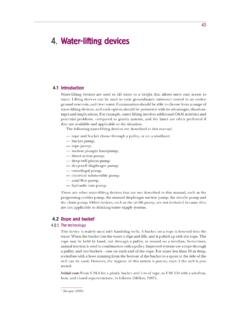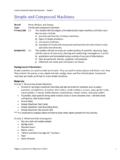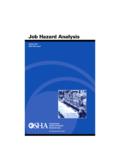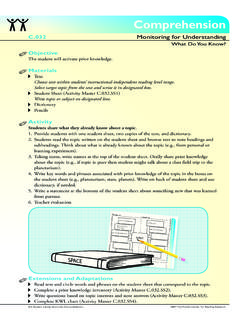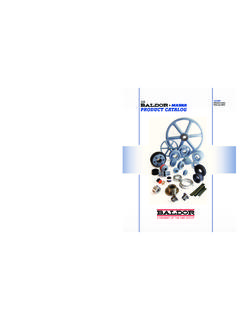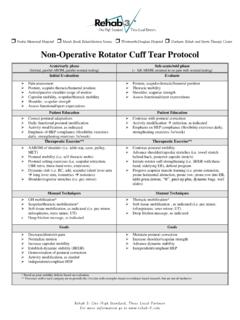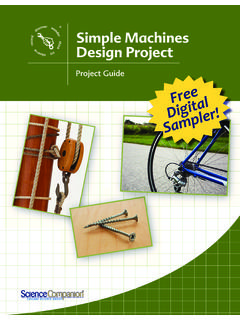Transcription of 2.3 Mechanical Advantage - Brian Aspinall
1 40 Chapter 2 Getting to WorkNELF igure 1 This claw hammer pulling a nail out of a piece of wood has a Mechanical Advantage of PROBLEM 1: Determine Mechanical Advantage of a Wheelbarrowfulcrumeffort arm120 cmload arm40 cmFigure 2 This wheelbarrow multiplies the input force 3 wheelbarrow in Figure 2 has an effort arm 120 cm long and a load arm 40 cm long. What is its Mechanical Advantage ?Given: effort arm length = 120 cm load arm length = 40 cmRequired: Mechanical Advantage (MA)Analysis: MA = effort arm length _____ load arm length Solution: MA = 120 cm _____ 40 cm MA = 3 Statement: This wheelbarrow has a Mechanical Advantage of : A wheelbarrow has an effort arm that is m long and a load arm that is m long. What is the Mechanical Advantage of the wheelbarrow?
2 HANDBOOKM echanical AdvantageTh e designers of physical systems know from experience that there are many diff erent ways of accomplishing the same task. For example, nails may be pulled out of a piece of wood with machines such as a pair of pliers or a claw hammer (Figure 1). Th e claw hammer does the job with less eff ort. Why is this the case? Th e hammer acts as a fi rst class lever that converts a small input force into a much larger output force. When a machine turns a small input force into a larger output force, we say that the machine gives us a Mechanical Advantage . Mechanical Advantage (MA) is the ratio of the output force to the input force (for example, the output force divided by the input force).Imagine a hammer pulling a nail out of a piece of wood. If the hammer produces an output force 15 times greater than the force you apply to it (the input force), then the hammer has a Mechanical Advantage of 15.
3 Mechanical Advantage has no units; it is simply a comparison or ratio. When the input and output forces are the same, the Mechanical Advantage is 1. Machines with a Mechanical Advantage greater than 1 generally make tasks easier and faster to way of estimating the Mechanical Advantage of a lever is to compare the length of the eff ort arm with the length of the load arm. Th e formula for Mechanical Advantage in this case isMA = eff ort arm length _____ load arm length Mechanical Advantage : the ratio of output force to input force for a given 4010/17/08 10:44:06 AM10/17/08 10:44:06 AM Mechanical Advantage 41 NELIt is possible to have a Mechanical Advantage of less than 1. Th is happens when the input force is greater than the output force. A hockey stick (Figure 3), a class 3 lever, requires an input force much greater than the output force.
4 What good is such a machine? Th e benefi t of the hockey stick is that it increases the distance and speed of the output. Th e end of the stick travels faster and farther than the player s hands do. Th e hockey stick transfers this motion to the puck. Th is means that the puck travels faster and a greater distance than it would have if the player hit the puck with his or her hand or can also estimate the Mechanical Advantage of machines by comparing input and output distances. Using distances, Mechanical Advantage is equal to the ratio of input distance to output distance: MA = input distance _____ output distance Input distance refers to the distance over which the input force is applied; output distance refers to how far the load moves. For a single pulley (Figure 4), the input distance and the output distance are the same, so Mechanical Advantage is 3 Although the Mechanical Advantage of a hockey stick is less than 1, the benefi t is the speed and distance that the blade at the end of the stick lift a load 5 cm with a pulley system, 15 cm of string had to be pulled.
5 What is the Mechanical Advantage ?Given: input distance = 15 cm output distance = 5 cmRequired: Mechanical Advantage (MA)Analysis: MA = input distance _____ output distance Solution: MA = 15 cm _____ 5 cm MA = 3 Statement: The pulley system has a Mechanical Advantage of : What is the Mechanical Advantage of a pulley system if 4 m of string had to be pulled to lift a load to a height of 1 m?SAMPLE PROBLEM 2: Determine Mechanical Advantage of a Pulley System20 cm20 cmFigure 4 A single pulley has a Mechanical Advantage of 1. 4110/17/08 10:44:14 AM10/17/08 10:44:14 AM42 Chapter 2 Getting to WorkNELI deal Mechanical Advantage versus Actual Mechanical AdvantageSample problems 1 and 2 describe a form of Mechanical Advantage called ideal Mechanical Advantage .
6 Th e ideal Mechanical Advantage is what the Mechanical Advantage would be if all of the input force could be converted into an output force. However, this is never possible in real-world applications. Th ink back to the claw hammer in Figure 1. Not all of the eff ort applied to the hammer will be used in pulling the nail from the wood. Friction between the wood and the nail will cause some of the input force to be turned into thermal energy in the wood and the nail (for example, the wood and nail heat up a little). Also, some of the input force may be used in causing the wood to dent or in producing sound. Actual Mechanical Advantage is the Mechanical Advantage that actually occurs. It is the ideal Mechanical Advantage minus any force lost to factors such as internal friction, slippage, and distortion.
7 How do we determine the actual Mechanical Advantage of a machine? We do so by measuring the actual forces involved. Actual Mechanical Advantage can be calculated by dividing a measured output force by a measured input is formula uses measured forces to calculate Mechanical Advantage :actual MA = measured output force _____ measured input force ideal Mechanical Advantage : the Mechanical Advantage of a machine if all of the input force is converted into output force; never possible in real-world applicationsactual Mechanical Advantage : the Mechanical Advantage of a machine in real-world applications; equal to ideal Mechanical Advantage minus force lost to friction, slippage, and distortion Imagine that you are lifting a patio stone using a pry bar as a lever (Figure 5).
8 If the input force applied is measured as 25 N and the output force is measured as 250 N, then what is the actual Mechanical Advantage ?Given: measured input force = 25 N measured output force = 250 NRequired: actual Mechanical Advantage (MA)Analysis: actual MA = measured output force _____ measured input force Solution: actual MA = 250 N _____ 25 N actual MA = 10 Statement: The lever has an actual Mechanical Advantage of : What is the actual Mechanical Advantage of a lever if the input force is measured as 37 N and the output force is measured as 185 N?SAMPLE PROBLEM 3: Determine Actual Mechanical Advantage of a Lever25 N250 NFigure 4210/17/08 10:44:26 AM10/17/08 10:44:26 Mechanical Advantage 43 NELTRY THIS: Mechanical Advantage of a LeverBy measuring the length of the effort and load arms of a lever, and then measuring the forces involved, you can compare actual and ideal Mechanical and Materials: textbook; plastic bag; newton spring scale; metre stick; chair1.
9 Put a textbook in a plastic bag and measure the force needed to lift it. This is the measured output Make a class 2 lever using a metre stick, the back of a chair as a fulcrum, and the book in the bag as the Hook the spring scale onto the metre stick and measure the force required to hold up the load, the length of the load arm, and the length of the effort Use these measurements to determine the actual Mechanical Advantage and the ideal Mechanical Advantage . If time allows, repeat using different distances or a different class of How did your actual value compare with the ideal value? B. Sketch the arrangement you used. Include all appropriate MENU: planning, performing, observing, analyzingYou can also use the actual Mechanical Advantage equation to determine the actual Mechanical Advantage of pulley systems.
10 CHECK YOUR LEARNING1. What is the meaning of Mechanical Advantage ?2. (a) If an output force is fi ve times larger than an input force, what is the Mechanical Advantage ? (b) If an input of N is required to lift a rock of 36 N, what is the actual Mechanical Advantage ? Show your (a) The Mechanical Advantage of a class 3 lever will always be less than 1. Explain why.(b) If there is no Mechanical Advantage to class 3 levers, why are they considered useful?4. What parts of a pulley system will cause the actual Mechanical Advantage to be less than the ideal Mechanical Advantage ?Th e sensitivity of tools (scales) used to measure forces may need to vary depending on how large or small the force is, or how accurate the reading needs to be. However, as you will see in the activity below, a force, whether large or small, is always needed when work is pulley system in Figure 6 is being used to raise a load.


